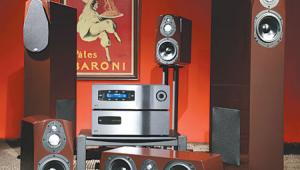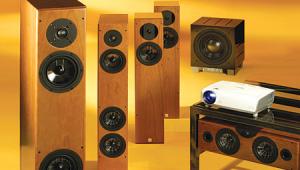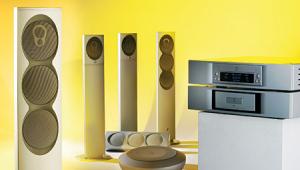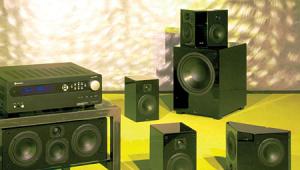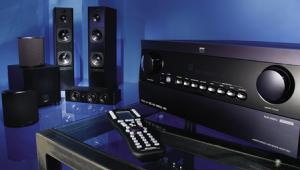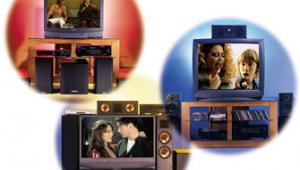Polk Audio RM40T Speaker System, Hitachi 42HDT52 Plasma HDTV, Yamaha RX-4600 A/V Receiver, and Yamaha DVD-S2500 DVD Player
My basement audio/video system is so last century. It's a mix-and-match collection of gear that's been retired as I've put together my real home theater system upstairs. The TV, a 30-inch analog CRT, circa 1988, doesn't even have a flat picture tube to its credit. The receiver maxes out at four-channel Dolby Pro Logic, and the speaker system is a mishmash of center and surround speakers (unmatched), with unshielded front speakers that deliver a killer image with stereo music but an unwelcome rainbow of colors when placed next to a video display. The DVD player is the only current-millennium piece in the stack, but not by much.
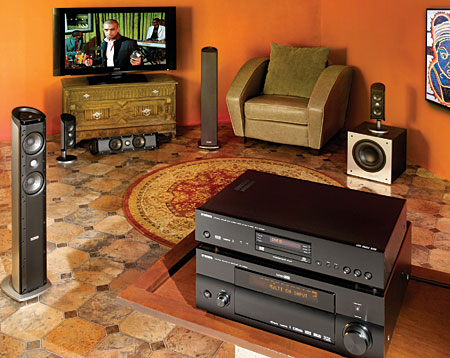
So, the idea of bringing this corner of my house into the digital age—even for a few weeks—was a fun one. The assignment was to put together an A/V system that cut the edge without breaking the bank—or taking over the room. To minimize the amount of room real estate required, I'd put in the requisite flat-panel TV and whittle down the number of wires where possible. There would be a matched 5.1-channel speaker system, and I'd give digital broadcast radio a ride. I chose the Hitachi 42HDT52 plasma HDTV, the Yamaha RX-4600 A/V receiver and DVD-S2500 DVD player, and an RM Series speaker system from Polk Audio.
My first step was to hook up the Hitachi display. I already had a CableCARD from a previous review model—also a Hitachi—so I figured I'd be able to switch cards without a problem. When the cable service detected the card, though, the screen displayed a message giving me a number to call for activation. I called and was told a technician would have to come to the house and "set up communication between the card and the TV." Hmm. Isn't one of the purposes of CableCARD to simplify the HDTV setup process? Apparently not if you're a cable company.
 The funny thing is, when the cable guy arrived the next day, the signal suddenly appeared, and the onscreen message had disappeared. I got all of the HD channels that I get upstairs with my HD cable box. It surprised the installer as much as it did me. "You never know; it might go out again," he told me, adding that his specialty is cable modems, not CableCARD, and he didn't know why he was given this assignment at all. In fact, he told me, there's very little CableCARD business.
The funny thing is, when the cable guy arrived the next day, the signal suddenly appeared, and the onscreen message had disappeared. I got all of the HD channels that I get upstairs with my HD cable box. It surprised the installer as much as it did me. "You never know; it might go out again," he told me, adding that his specialty is cable modems, not CableCARD, and he didn't know why he was given this assignment at all. In fact, he told me, there's very little CableCARD business.
The next issue involved TV Guide Onscreen. The Hitachi setup guide prompted me through a series of questions regarding ZIP code and cable connections. But there was no CableCARD option—just an option for a cable box, which I don't have. The guide never downloaded over the promised 24-hour period, so this time I called Hitachi.
After some checking, we discovered that the TV setup did its job, but Cablevision is not sending the digital channel information over the local PBS channel, so there's no program info for TVGOS to capture. That rang a bell. Sony wanted to provide me with an HD DVR for this review but couldn't because Cablevision doesn't provide guide data. If I weren't environmentally conscious, I'd hack my way through the trees for a satellite signal and ditch cable altogether. Instead, I'll sit on channel 100 and wait for hundreds of channels to scroll around like I did in the analog days.
Once I managed to pull in the Yankees in HD, life got a whole lot better. At first, I noticed the picture's contrast, especially in the grass at Yankee Stadium. It looked like each blade had a reflective coating. I went into the video menu, and, sure enough, contrast was set at 100 percent. I knocked it down to the mid-50s, toned down Enhanced Black to mid-level from high, and switched the color-temperature setting from high to medium. I kept Hitachi's Dynamic Contrast mode engaged, which seemed to help reduce video noise. After the tweaks, I was impressed with the black level, along with the palette of colors that balanced the line between realistic and overly saturated, which I've seen on some digital displays. The detail was very sharp, with only a minimum of noise in color backgrounds. My basement took a wide turn toward the upscale.
Yamaha
Flat panel or no, the display is only part of the home theater story. Next, I hooked up the audio and video gear, including the control center of this ensemble, the Yamaha RX-4600 A/V receiver. Part of the upper-middle class in Yamaha's A/V receiver lineup, the RX-4600 can power seven channels of surround sound. That's two more speakers than I can handle in my room, so I used it in 5.1-channel mode. Additional step-up features include HD Radio capability, Yamaha's proprietary YPAO setup system that adjusts speaker parameters according to measurements taken at the listening position, and HDMI connectivity: two inputs and one output.
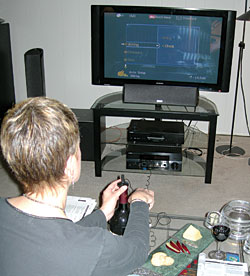 Being able to connect the Yamaha DVD-S2500 DVD player with a single cable for all audio and video channels was my favorite part of the deal from the get-go. If I had wired it the old-fashioned way, I would have had 10 wires messing around behind my see-through audio/video stand: a coaxial connection for digital audio, plus six analog RCA cables for DVD-Audio, and three cables for component video. The idea of a single connector was too good to be true. Yes, indeed. There was the GUI catch. I still needed to run an S-video cable for onscreen graphics from the receiver to the TV. Grrrr! Still, I'm an HDMI convert and can't wait for the price of wire consolidation to come down. Neither Yamaha product came with an HDMI cable, which I priced at $60-plus at the local RadioShack.
Being able to connect the Yamaha DVD-S2500 DVD player with a single cable for all audio and video channels was my favorite part of the deal from the get-go. If I had wired it the old-fashioned way, I would have had 10 wires messing around behind my see-through audio/video stand: a coaxial connection for digital audio, plus six analog RCA cables for DVD-Audio, and three cables for component video. The idea of a single connector was too good to be true. Yes, indeed. There was the GUI catch. I still needed to run an S-video cable for onscreen graphics from the receiver to the TV. Grrrr! Still, I'm an HDMI convert and can't wait for the price of wire consolidation to come down. Neither Yamaha product came with an HDMI cable, which I priced at $60-plus at the local RadioShack.
The RX-4600 utilizes Yamaha's YPAO setup feature. You place your speakers in the typical layout and then set up a microphone in the listening position. The mike collects data that YPAO crunches to adjust the sound for room anomalies (and boy, does my basement have 'em!). You can do it manually if you want, but the automatic setup gives you a starting point. If you're a perfectionist, you can tweak to your heart's content. I was happy with the Yamaha equation.
The manual suggested placing the mike on a tripod. I didn't have one, so I used a magnum of cabernet waiting for a special occasion (still corked), and it turned out to be an able substitute. Part of the setup process includes checking wiring, and I was impressed when the software noticed that one of my speaker wires had dislodged. I wouldn't have known, since there was a mounting bracket hiding the wire on the right surround speaker. During the next step, I discovered that I had reversed the polarity of the left front speaker wires at the receiver. Thanks, YPAO!
